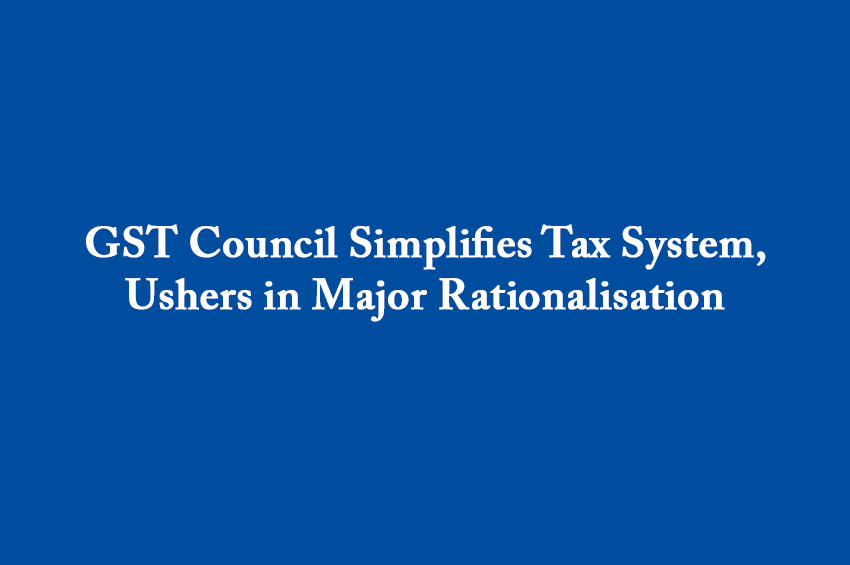Winning Bizness Economic Desk
In its 56th meeting held on September 3, the Goods and Services Tax (GST) Council decided to majorly rationalise the GST rates by eliminating the existing 12 per cent and 28 per cent tax slabs.
This will help streamline the structure into two main rates—five per cent and eighteen per cent and this new structure will come into effect from September 22.
India’s Finance Minister Mrs Nirmala Sitharaman who chaired the meeting said that “We’ve reduced the slabs. There shall only be two slabs and we are also addressing the issues of compensation cess.”
¬¬A point that needs highlighting here is that there will now be a new 40 per cent slab which will be introduced specifically for sin and luxury goods.
As a part of the restructuring, around 175 mass consumption items including essentials such as milk, paneer, bread and snacks will register a decline in prices.
An important point to note here is that nearly 99 per cent of the products earlier taxed at 12 per cent will now attract only a five per cent GST. As can be seen, this five per cent is a very much lower figure indeed.
Similarly, about 90 per cent of goods previously under the highest 28 per cent slab will now be shifted to the much lower 18 per cent slab.
The new rate of 40 per cent will be levied on some luxury and de-merit goods such as tobacco products and paan masala. This is known as the sin tax.
Here, it is important to highlight the fact that this is considered by experts as one of the most significant tax reform initiatives undertaken since the introduction of the GST regime eight years ago in 2017.
This initiative is expected to increase and simplify compliance, lessen litigation and provide relief to consumers.
GST Rates Rationalisation Aims to Provide Relief to Common Man
India’s Union Finance Minister Mrs Nirmala Sitharaman has said that the Goods and Services Tax (GST) on the common man and middle-class have been moved southward from the two slabs of 18 per cent or 12 per cent to the much lower five per cent.
On September 3, the GST Council has approved this rate rationalisation. This initiative is expected to positively impact the common man, labour-intensive industries, farmers and agriculture, health and other key drivers of the economy.
This major change will take effect from September 22 which, incidentally, is also the first day of Navaratri.
Following the rates rationalisation, there will now be no GST on all individual life insurance policies and all individual health insurance policies, including family floater policies and policies for senior citizens and re-insurance.
This will make insurance affordable for the common man, Mrs Sitharaman pointed out.
On the health and medical fronts as well, GST rates rationalisation has been done. Following this, GST on about 33 life-saving drugs and medicines has been brought down from 12 per cent to zero.
On three life-saving drugs used for the treatment of cancer, rare diseases and other severe chronic conditions, GST has been reduced to zero from the previous five per cent.
An important highlight here is that GST on various medical apparatus and devices used for medical, surgical, dental or veterinary purposes or for physical and chemical analysis has also been moved down from 18 per cent to the significantly lower five per cent.
Now only the lowest slab of five per cent GST will be applicable on items such as hair oil, toilet soap, soap bars, shampoos, toothbrushes, tooth paste, bicycles, tableware, kitchenware, and other household articles.
Food items such as namkeen, bhujia, sauces, pasta, instant noodles, chocolates, coffee, preserved meat, cornflakes, butter and ghee are also now placed in the lowest slab of five per cent from the earlier higher 12 per cent or 18 per cent.
Also lowered from 28 per cent to 18 per cent are items such as air-conditioning machines, TV sets above 32 inches, all types of TVs, dishwashing machines, small cars and motor-cycles.
Mrs Sitharaman said that labour-intensive industries should benefit from the rate rationalisation; additionally, farmers and the agriculture sector will also benefit from the initiatives.
Importantly, GST on all agricultural equipment has been reduced from 12 per cent to five per cent.
CAIT Welcomes GST Reforms, Says Will Benefit Consumers
The rate reduction and reforms coupled with the restructuring of tax rates are historic and revolutionary, CAIT, a traders’ body said.
On September 3, the GST Council announced a raft of initiatives designed to rationalise the tax rates and provide relief to consumers. It not slashed rates significantly but also announced the removal of two slabs—28 per cent and 12 per cent—and having only two principal rates, that of five per cent and eighteen per cent.
“These reforms will not only benefit small traders, consumers and India’s economy, but will also simplify the tax structure and significantly boost consumption thereby giving new momentum to economic activities and trade,” the Confederation of All India Traders (CAIT) said.
The traders’ body Secretary General and Member of Parliament from Chandi Chowk in New Delhi, Mr Praveen Khandelwal, said that the tax reduction on more than 400 items will provide a major relief to the common people. Additionally, this move will also strengthen the efficiency of the tax system, he added.
“This will make health and life insurance premiums more affordable. In the aftermath of the pandemic and amid rising healthcare costs, this step will prove extremely important for common families and will encourage wider insurance coverage,” the CAIT senior official observed.
GST compliance has now been made easier and will also become less expensive. Besides, having only two primary tax slabs will improve revenue collection and bring greater stability to the business environment,” he said.
Madhya Pradesh Attracts Rs 12,508-cr Investment Proposals in Textile Sector
Leading Indian conglomerates have evinced an interest in investing in the textile sector in the central Indian state of Madhya Pradesh (MP).
Fifteen companies have proposed investments totalling Rs 12,508-crore in the PM MITRA Park being developed in Dhar district in the state.
This is expected to generate around 18,000 jobs.
The state’s Chief Minister Mr Mohan Yadav held direct discussions with industry leaders from the textile and garment sectors. He said that the state was adopting the Prime Minister’s 5F vision—Farm to Fibre to Factory to Fashion and Foreign.
Among the leading companies which have proposed investments are Trident (Rs 4,500-crore), Arvind Mills (Rs 1,024-crore), Best Corporation Tiruppur (Rs 832-crore), RSVPM (LNJ Bhilwara) (Rs 700-crore) and RR Jain Industries (Rs 550-crore), among others.
Madhya Pradesh has the advantage of being centrally located in the country and offers multiple advantages to investors, Mr Yadav said, pointing out that the Delhi-Mumbai Industrial Corridor passes through the state.
He assured investors that land, electricity, water, approach roads, connectivity and affordable skilled labour would be provided wherever they chose to invest.
An important point he highlighted relates to labour peace—Mr Yadav said that Madhya Pradesh was perhaps the only state in India where industrial strikes are virtually non-existent.
Godrej Properties Sells 683 Units Worth Rs 1,000-cr in Hyderabad
Godrej Properties Limited recently said that it has sold 683 housing units for more than Rs 1,000-crore in its new residential project in Hyderabad.
In late-August, the company said that driven by strong consumer demand, it has sold units worth over Rs 1,000-crore in its project, the Godrej Regal Pavilion, located at Rajendra Nagar in the southern city.
The company had sold 683 units comprising a total area of 1.20-million sq. ft. The total developable area in this large project is 4.14-million sq. ft with an estimated revenue potential of Rs 3,600-crore.
Here, it must be highlighted that recently, Godrej Properties acquired a 7.82-acre land parcel in Hyderabad through the auction process for Rs 548-crore.


